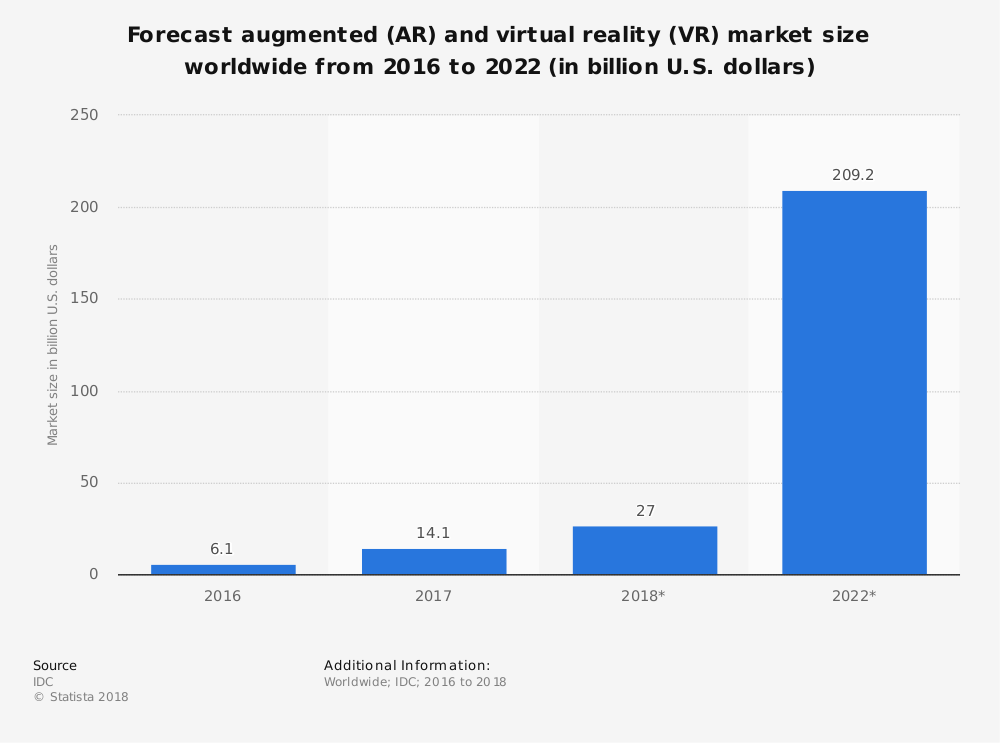It seems almost primitive today to share data and visual ideas through static pie charts, bar graphs and the like. We now have the ability to deliver dynamic, interactive visuals that communicate insights faster, more effectively and in real time. Is virtual reality, then, the future of data visualization? Take a look at the examples of the incredibly beautiful visualization of the #MeToo movement from Google Trends or Washington Post’s Sea of Steel visualization.
There’s just one problem. The amount of data coming in has grown considerably, even when there are only a handful of sources involved. So many apps, devices, and tools are now regularly collecting data, it provides an endless stream of information, but also an infinite stream of maintenance and revision for data visualizations.
2D or even 3D images on a flat surface — like a conventional monitor or TV — will soon be limited so much that it leads to sub-par visual experiences, at least when it comes to data visualizations.
Cue virtual or augmented reality technologies, already successful by any means. Experts expect the global augmented virtual reality market size to be worth $209 billion by 2022. Comparably, the global virtual reality software market size will be worth $6.4 billion by 2021. That’s massive.

The technology also has a ton of potential in the data visualization and analytics industry. Imagine a virtual space or experience where you can manipulate, review and create data with 360-degree precision. It’s a very sci-fi and Minority Report-esque concept that could see everyone — from the average consumer to company executives — reviewing data in a virtual space.
It will completely alter the way we view data. For instance, business presentations often take place in a conference-style environment, with professionals or executives seated around a table gazing at a projector screen. In virtual reality, that setting could change completely. You could give a presentation on a virtual beach, for example, or an alien planet. And as far-fetched as it sounds, it can help the data visualizations and resulting presentation, especially when you tailor the virtual environment to the existing content or topic.
Virtual Reality as the Future of Data Visualization: New Strategies
By nature, data visualization doesn’t lend itself to fun or entertainment. In more serious environments, that can be a good thing, but it can also affect the data to convey. Audiences, for instance, may be less inclined to pay attention or heed the information if it’s in a bland, conventional format.
Virtual reality has the potential to offer so much more in the way of innovation and interest when it comes to experience. Take Arwa Michelle Mboya’s project Night at the Museum project (below), for example. It offers an incredible mobile-friendly virtual reality experience, meant to present findings in varying 3D-oriented scenes such as you might see at a museum, science fair or “gallery-like space” in the real world.
Aside from entertainment, VR and AR technologies can also offer more practical use cases when it comes to data manipulation, processing, and review. It’s possible to present data in a 3D canvas, wrapping around us visually to offer more advanced and natural ways to interact with it. Cross-referencing applications can also allow for discovery and pattern recognition in more efficient ways.
Virtualitics is an AI and VR provider that is already working on these kinds of experiences. They call it “immersive analytics,” which surrounds viewers visually and gives them full control alongside access to smart mapping or AI support, which they can use to explore and understand data sets. We’re talking multi-dimensional data analysis, augmented by incredibly natural interactions and support.
Going Beyond Simple Experiences
Unfortunately, few applications offer VR-enabled data visualization in today’s landscape. It’s a relatively new concept that will require time and dedication to reach its full potential, namely from the developers and software engineers in the space.
In its current state, most VR and AR data visualization experiences allow for shallow interactions. You can move, reshape and view data in new forms, but you can’t do much more than that. DatavizVR is a great example of this — the app allows users to visualize and display data sets, yet that’s all. It certainly leaves something to be desired in the way of more advanced experiences and presentations.
For the technology to really become useful in the industry, we’ll need to see new, custom experiences that allow for more control over the resulting data.
Imagine, for instance, an onsite development planner who can map out an entire project before them through visualized progress, spec details, safety statistics and worker insights, all presented via a virtual space. Yes, that data and information can be visible almost instantly, but presenting it in a more meaningful way means crafting such experiences at a software level. The finely crafted experiences become even more significant as you start to consider how the user might want to manipulate, edit or review the data they see.
It’s not as if nobody has made any reliable virtual reality visualizations. There are actually quite a few, like Google Labs’ Brexit visualization or The New York Times’ Pluto experience. But you’ll notice that many of them have are not necessarily the kind of data visualizations and content you’d see in a business environment.
Therein lies the major question for modern applications of VR in data and analytics: How will professionals use the technology and space?
Is VR the Answer?
In the end, it’s important to understand even though we’re seeing a lot of promise and potential, it will take some time for the technology to really come into its own in the data visualization world. VR looks promising as the future of data visualization but businesses and academia have a long way to go before actually employing it.
On top of new forms of technology and hardware innovations, the developer and software engineers need to build and design virtual experiences. Furthermore, we’re still working out ways in which virtual and augmented reality can be useful to this end. What’s the best way to allow data manipulation and editing in a 3D environment? How do we generate systems that allow for data imports and procedural visualization models? We’ll have to figure all that out in due time.
——–
Kolabtree is a platform that allows you to hire freelance scientists from MIT, Cambridge, Oxford, and other institutions all over the world. Get in touch with a scientist today!







